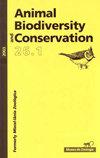比斯开湾东南部黄腿鸥(Larus michahellis)巢中塑料的边缘存在
IF 1
4区 环境科学与生态学
Q3 BIODIVERSITY CONSERVATION
引用次数: 2
摘要
比斯开湾东南部黄腿海鸥(Larus michahellis)巢穴中塑料的边缘存在。鸟巢缠绕和塑料消耗可能是导致各种海鸟雏鸟死亡的原因。由于塑料碎片可能被选为筑巢材料的来源,因此评估其在海鸟群落中的存在及其对筑巢的贡献非常重要。在这里,我们确定了人为碎片对黄腿海鸥Larus michahellis种群筑巢的贡献,该种群在很大程度上依赖垃圾堆觅食。2019年,对西班牙比斯开湾东南部的两个殖民地进行了采样。其中一个群落在Getaria,那里的巢穴中没有发现碎片,第二个群落在Ulia,那里40%的巢穴都有某种人造材料。然而,在所有情况下,这些碎片只占巢穴面积的不到5%。在研究的巢穴中,我们发现一个有一块织物,五个有绳子,20个有柔性塑料包装。这些结果与其他海鸟形成了鲜明对比,这些海鸟由于越来越多地使用塑料筑巢而面临保护问题。由于本研究中发现的巢穴中人工碎片(主要是塑料碎片)的发生率较低,因此不太可能因碎片缠绕或摄入而死亡。本文章由计算机程序翻译,如有差异,请以英文原文为准。
Marginal presence of plastic in nests of yellow–legged gulls (Larus michahellis) in the southeastern Bay of Biscay
Marginal presence of plastic in nests of yellow–legged gulls (Larus michahellis) in the southeastern Bay of Biscay. Nest entanglement and consumption of plastics can be a cause of mortality in chicks of various seabird species. As plastic debris may be chosen as a source of nesting material, evaluation of its presence and contribution to nest building in seabird colonies is important. Here, we determined the contribution of anthropogenic debris to nest construction by a yellow–legged gull Larus michahellis population that largely depends on refuse tips to forage. Two colonies within the southeastern Bay of Biscay, Spain, were sampled in 2019. One of the colonies was in Getaria, where no debris was found in nests, and the second was in Ulia, where 40 % of the nests had some kind of artificial material. In all cases, however, this debris comprised less than 5 % of the nests' area. Among the studied nests, we found one had a piece of fabric, five had pieces of rope, and 20 had pieces of flexible plastic packaging. These results contrast with other seabird species that face problems of conservation due to the increasing use of plastic for nesting. With the low prevalence of artificial debris (chiefly plastic) in nests found in this study, mortality due to debris entanglement or ingestion is unlikely.
求助全文
通过发布文献求助,成功后即可免费获取论文全文。
去求助
来源期刊

Animal Biodiversity and Conservation
农林科学-动物学
CiteScore
2.00
自引率
0.00%
发文量
21
审稿时长
>12 weeks
期刊介绍:
Animal Biodiversity and Conservation (antes Miscel·lània Zoològica) es una revista interdisciplinar, publicada desde 1958 por el Museu de Ciències Naturals de Barcelona. Incluye artículos de investigación empírica y teórica en todas las áreas de la zoología (sistemática, taxonomía, morfología, biogeografía, ecología, etología, fisiología y genética) procedentes de todas las regiones del mundo. La revista presta especial interés a los estudios que planteen un problema nuevo o introduzcan un tema nuevo, con hipòtesis y prediccions claras, y a los trabajos que de una manera u otra tengan relevancia en la biología de la conservación. No se publicaran artículos puramente descriptivos, o artículos faunísticos o corológicos en los que se describa la distribución en el espacio o en el tiempo de los organismes zoológicos.
 求助内容:
求助内容: 应助结果提醒方式:
应助结果提醒方式:


